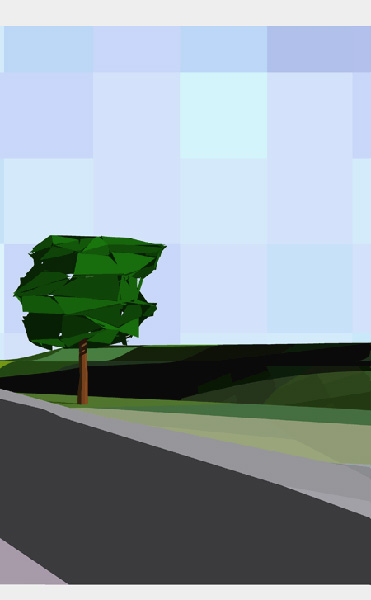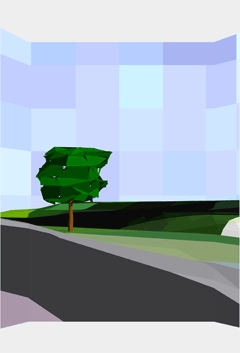|
| Plane
Old Landscape Three Planes in One |
||||
|
This picture uses three planes to show one picture plane. If it is a representation of the picture plane and not the picture plane itself what is the picture plane and what is being represented? When looked at from directly in front of the painting the painting is not in it's 'proper' picture plane. The front exists for the side. The so called picture plane only exists as a reference for where the artist meant it to be seen from and when manipulated, especially when the viewer already has preconception or experience in a similar situation, can trick the eye (trompe loei'l). This has to to be perspectival only in the changing of the perspective of the picture plane. It is what the viewer expects to see perceptively that is challenged by the changing picture plane. The flat version below still has a strong effect in reverse, with the sides projecting towards you.
|
||||
|
||||
| If it is impossible to see the picture plane and the representation at the same time, when looking at a picture or painting, for if the picture plane is observed the representation upon it is being ignored. E.H. Gombrich quotes in his book Art and Illusion "To understand the battle horse (a particular image) is for a moment to disregard the plane surface, we cannot have it both ways." note1 But is this true? (in the conventional sense). If the representation is of a picture plane or picture planes in tension with the real picture plane or planes then the real picture plane is made objective within the representation. We can have it both ways. The use of two real picture planes to represent one other plane uses all three in relation to each other each dominating at certain views. In this way the representation can have different meanings or signifiers from different viewpoints. One viewpoint could be a formalist abstract composition and the other more contextual or narrative image, the incongruence of the image changing depending upon picture plane orientation. A square is not a square if looked at from anywhere other than front on but we still perceive and understand it to be a square when looked at from other angles. Does thid mean that formalist compositions do the same? This depends on the strength of the tension within the compostion but at some point it becomes incongruent. This point of loss can be changed by adding other elements or by having the composition become part of another representation from another viewpoint where the incongruent compostion becomes part of some other. Similalary a narrative representations incongruence could lead to a formalist composition.
|
||||
|
||||
|
||||
|
||||
|
||||
note 1 : Referring to the quote of Maurice Denis" remember that a picture,before being a battle horse, a nude woman, or some anecdote, is essentially a plane surface covered with paint in a certain arrangement." |
||||

